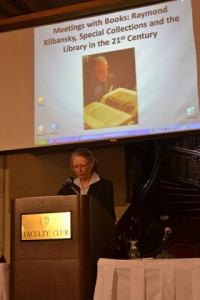Many of the books held at McGill are part of the larger history of Quebec libraries and readers beyond the university. Several of the named special collections held in Rare Books and Special Collections reflect this, and we find local names including Sheila Bourke, Norman Friedman, Rodolphe Joubert, Raymond Klibansky, Lawrence Lande, Max Stern…
But there are many less visible examples. One such can be seen in the dozens of books that were previously owned by the Literary and Historical Society of Quebec (LHSQ).
The LHSQ was founded in Quebec City in 1824 by George Ramsay, 9th Earl of Dalhousie, governor-in-chief of British North America 1820-28. It was open to francophones and anglophones from its beginning, and is the oldest learned society in Canada that is still in existence.
Volumes at McGill previously owned by this library, or likely to have been held by it for a time (e.g. from other libraries known to have been acquired by the LHSQ), date from the 15th to the 19th century on topics ranging primarily across history, literature, philosophy, religion and science. They offer a glimpse of the interests and acquisitions of earlier Quebec readers, and preserve part of the history of personal and institutional collections through various signs of changing ownership and use.
Indications of LHSQ and related ownership.
From 1868, the LHSQ library was housed within Morrin College, now the Morrin Cultural Centre, where it remains today. The library continued to grow through gifts from personal libraries as well as by absorbing other libraries. It had already absorbed in 1866 the libraries of the Quebec Library Association and the earlier subscription library called simply the Quebec Library, formed in 1779.
The LHSQ also took over the supervision, in 1916, of the separate “Aylwin Library” of Morrin College, which had been established some years earlier through the donation of the private library of Quebec lawyer, politician and judge Thomas Cushing Aylwin (1806-1871), an original member of the LHSQ and grandson of Thomas Aylwin (c. 1729-1771), one of the early British settlers in Quebec.
Books from these libraries can be identified in a variety of ways: there are more than two dozen titles with LHSQ-related provenance, identifiable through a variety of provenance evidence types recorded in the notes of catalogue records*. Types of provenance noticed to date are shown below.
*In order to search only the Notes fields of catalogue records for terms like “Literary and Historical Society”, “Aylwin”, “Morrin” or “Quebec Library”, use the Advanced Search of the Classic Catalogue.
Let us know if you notice these signs in books for which the provenance is not recorded!

Oval stamp [1] of the LHSQ |

Oval stamp [2] of the LHSQ |

Oval stamp [3] of the LHSQ |

Round stamp of the LHSQ |

French LHSQ bookplate |
 Morrin College stamp Morrin College stamp |

Aylwin Library stamp |

Signature of T.C. Aylwin |

Embossed stamp; Aylwin family arms(?) |

LHSQ, in manuscript
|

Manuscript presentation to Morrin College |

Quebec Library Association shelf mark style |

Quebec Library Association embossed stamp |

Quebec Library Association stamp |

Quebec Library Association in manuscript |

Quebec Library embossed stamp |
|
|
 Two major figures from the history of New France were canonized on April 3rd 2014 by Pope Francis: Marie Guyart, better known as Marie de l’Incarnation (1599-1672), and Francis-Xavier de Montmorency-Laval, or François de Laval (1623-1708). Marie de l’Incarnation came to New France as an Ursuline nun in 1639, and helped to establish and run Canada’s first school, and François de Laval was the first Roman Catholic Bishop of New France, arriving in Quebec in 1659.
Two major figures from the history of New France were canonized on April 3rd 2014 by Pope Francis: Marie Guyart, better known as Marie de l’Incarnation (1599-1672), and Francis-Xavier de Montmorency-Laval, or François de Laval (1623-1708). Marie de l’Incarnation came to New France as an Ursuline nun in 1639, and helped to establish and run Canada’s first school, and François de Laval was the first Roman Catholic Bishop of New France, arriving in Quebec in 1659.




















